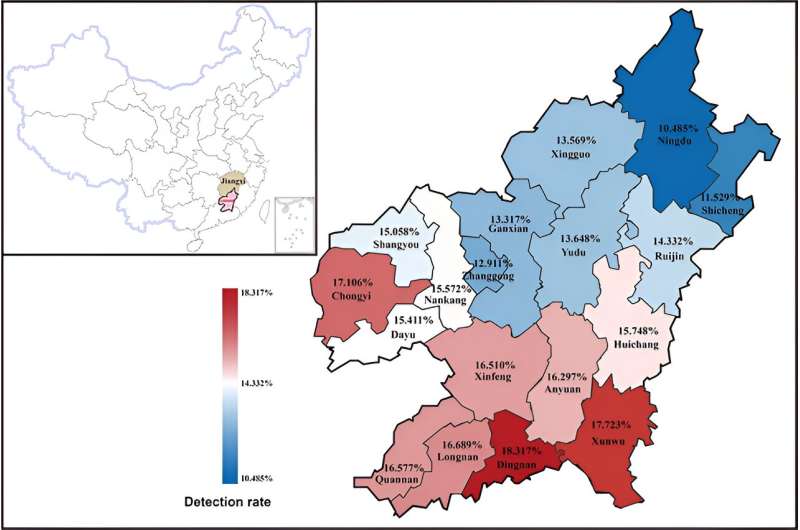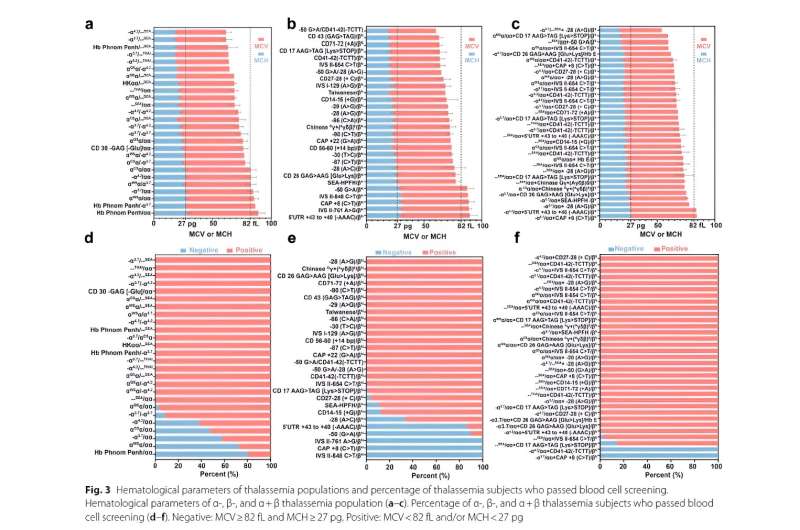This article has been reviewed according to Science X's editorial process and policies. Editors have highlighted the following attributes while ensuring the content's credibility:
fact-checked
proofread
Uncovering thalassemia diversity in southern China through next-generation sequencing

Around 5.2% of the global population carries abnormal hemoglobin genes. Each year, 300,000 to 500,000 children are born with severe hemoglobinopathies worldwide, with approximately 80% of these cases occurring in developing countries. Thalassemia is the most common hereditary hemoglobinopathy and occurs in 4.4 out of every 10,000 live births. It is prevalent in Mediterranean coastal areas, Africa, the Middle East, Southeast Asia, and southern China.
A previous study indicated that Ganzhou, the southernmost city in Jiangxi province, had a thalassemia prevalence as high as 9.49%. Still, it had limitations in terms of small sample size, non-representative population and limited mutation spectrum. A new study published in Human Genomics, looks at the prevalence and mutation spectrum of thalassemia in Ganzhou based on a large-scale thalassemia screening project involving 136,312 individuals.
In this study, the researchers retrospectively analyzed 136,312 individuals who participated in the "Implementation Plan for the Free Gene Detection of Thalassemia in Ganzhou City (2019–2022)."
Key findings:
- The researchers found a total of 19,827 (14.545%) thalassemia carriers, including 14,298 (10.489%) α-thalassemia carriers, 4,921 (3.610%) β-thalassemia, and 608 (0.446%) combined α- and β-thalassemia carriers.
- A total of 156 distinct thalassemia genotypes were identified, comprising 40 α-thalassemia genotypes, 42 β-thalassemia genotypes and 74 combined α-/β-thalassemia genotypes. 48 rare thalassemia mutations were identified, such as 5'UTR +43 to +40 (-AAAC), Chinese Gγ+(Aγδβ)0, —THAI, αfusion, -50 G > A, and Hb Phnom Penh.
- The prevalence of thalassemia was higher in the southeastern Jiangxi Province at the junction of Fujian, Guangdong, and Jiangxi Provinces. In particular, Dingnan and Xunwu had a high prevalence of 18.3% and 17.7%, respectively.
- Next-Generation Sequencing (NGS) techniques perform better than conventional thalassemia genetic screening methods, especially in identifying novel or rare thalassemia mutations. Limited by the low sensitivity of hematological analysis and the disadvantages of Polymerase chain reaction (PCR), a large number of novel or rare thalassemia variations would be missed or misdiagnosed using traditional screening methods. NGS is also a cost-effective tool for prenatal screening.
This study utilized large-scale thalassemia screening through NGS to uncover the prevalence and mutation spectrum of thalassemia in Ganzhou, demonstrating that thalassemia is a serious public health problem in this region. The findings will be very important for thalassemia prevention and control in Ganzhou and other high-prevalence areas. More importantly, the identification of rare and novel variations highlighted the necessity and significance of choosing NGS for thalassemia screening in large populations.

More information: Tong Yang et al, Next-generation sequencing analysis of the molecular spectrum of thalassemia in Southern Jiangxi, China, Human Genomics (2023). DOI: 10.1186/s40246-023-00520-5



















